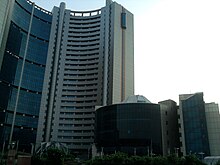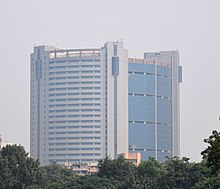Municipal Corporation of Delhi
Municipal Corporation of Delhi | |
|---|---|
 | |
| Type | |
| Type | Local Authority of the Delhi |
| Structure | |
| Seats | 372 (Now trifurcated into North, South and East) 104 (North) 104 (South) 64 (East) |
 | |
Political groups | Bharatiya Janata Party (181)
Aam Aadmi Party (49) Indian National Congress (31) |
| Elections | |
| First-past-the-post | |
Last election | April, 2017 |
Next election | 2022 |
| Meeting place | |
| MCD Civic Centre | |
| Website | |
| Official website | |
Municipal Corporation of Delhi (MCD) was the former municipal corporation that governed 8 of the 11 districts of the state of Delhi, India. The Municipal Corporation of Delhi was replaced by three new bodies, the North Delhi Municipal Corporation, the South Delhi Municipal Corporation and the East Delhi Municipal Corporation in 2012.[1][2] "The MCD was among the largest municipal bodies in the world providing civic services to more than estimated population of 11 million citizens in the capital city."[3] MCD was one of three municipalities in the National Capital Territory of Delhi, the others being New Delhi Municipal Council, and Delhi Cantonment Board. The municipal corporation covered an area of 1,397.3 km² (539.5 mi²).

Within its jurisdiction were some of the most densely populated areas in the world. It also had the unique distinction of providing civic services to rural and urban villages, resettlement colonies, regularising unauthorised colonies, unregularising slum/squatter settlements etc., all at the same time.
History[]

MCD came into existence on 7 April 1958 under an Act of Parliament. Prior to that DMC ( Delhi Municipal Committee ) was the principal civic body of Delhi. Eminent Freedom Fighter Guru Radha Kishan has the honour to represent MCD ( initially Delhi Municipal Committee ) for most consecutive years as a Councillor.[4] The first elected Mayor of Delhi was Pt. Trilok Chand Sharma served as First Mayor of Delhi. Since then, the Municipal Body has always been alive in its constitution and functioning to the growing needs of citizens. The 1993 amendment of the Act brought about fundamental changes in composition, functions, governance and administration of the corporation.
Trifurcation[]
On 13 January 2012,[5] the Municipal Corporation of Delhi was 'trifurcated', i.e. split into three smaller municipal corporations. The new North Delhi Municipal Corporation and South Delhi Municipal Corporation each contain 104 municipal wards, the smaller East Delhi Municipal Corporation contains 64 wards.[6][7]
MCD zones list[]
The entire MCD area was divided into 12 zones spread across three smaller municipal corporations:
- Pitampura
- Karol Bagh
- Sadar Paharganj
- Civil Lines
- Narela
- Rohini
- Shahdara South
- Shahdara North[11]
Amendment[]
The 73rd and 74th Constitutional Amendments were introduced in 1992 and were meant to facilitate greater decentralization at the rural and urban level respectively. They did so through providing legal status to local assemblies and entrusting them with more functions and greater powers. The inclusion of certain social categories that had historically been marginalized from policy making and implementing structures was fundamental to the project of decentralization. These social categories were the Scheduled Castes, Scheduled Tribes, and women. While the 73rd Amendment applies to the Panchayati Raj system, the 74th Amendment applies to Municipal Corporations, Municipal Councils, and Nagar Panchayats depending on the size of the city. The 74th Amendment states that:
Not less than one–third (including the number of seats reserved for women belonging to the Scheduled Castes and Scheduled Tribes) of the total number of seats to be filled by direct election in every Municipality shall be reserved for women and such seats may be allotted by rotation to different constituencies in a Municipality.
According to the system of rotation, the existing one-third seats would be de-reserved and another set of one-third seats would be reserved, and so on, in a cyclical manner in every successive election. However, before the 2002 elections, the BJP government then in power in Delhi state managed to freeze rotations, thus maintaining the existing pattern and location of reserved wards for all groups.[12]
Demographics[]
As of 2011 India census,[3] Delhi Municipal Corporation (U) had a population of 11,007,835. Males constitute 55% of the population and females 45%. Delhi Municipal Corporation (U) has an average literacy rate of 87.6%, higher than the national average of 74.0%: male literacy is 91.44% and, female literacy is 83.20%. In Delhi Municipal Corporation (U), 13% of the population is under 6 years of age.
Municipal elections[]
The municipal election of April 2017 saw the Bharatiya Janata Party of India (BJP) win the highest number of seats in each of the three new corporations. After nearly 12 years of running the MCD this was the fourth consecutive victory for the BJP.
The results of the election were counted and declared on 26 April 2017.
| S.No. | Party Name | Party flag or symbol | Number of Corporators | Seats Changed |
|---|---|---|---|---|
| 01 | Bhartiya Janata Party (BJP) | 64 | +5 | |
| 02 | Aam Aadmi Party (AAP) | 21 | NA | |
| 03 | Indian National Congress (INC) | 16 | −13 | |
| 04 | Others | 03 | −13 | |
| Total | 104 |
| S.No. | Party Name | Party flag or symbol | Number of Corporators | Seats Changed |
|---|---|---|---|---|
| 01 | Bhartiya Janata Party (BJP) | 70 | +26 | |
| 02 | Aam Aadmi Party (AAP) | 16 | NA | |
| 03 | Indian National Congress (INC) | 12 | −17 | |
| 04 | Others | 06 | −25 | |
| Total | 104 |
| S.No. | Party Name | Party flag or symbol | Number of Corporators | Seats Changed |
|---|---|---|---|---|
| 01 | Bhartiya Janata Party (BJP) | 47 | +12 | |
| 02 | Aam Aadmi Party (AAP) | 12 | NA | |
| 03 | Indian National Congress (INC) | 03 | −16 | |
| 04 | Others | 02 | −08 | |
| Total | 64 |
The results of the 2012 elections were:[13]
North Delhi[]
| S.No. | Party Name | Party flag or symbol | Number of Corporators |
|---|---|---|---|
| 01 | Bhartiya Janata Party (BJP) | 59 | |
| 02 | Indian National Congress (INC) | 29 | |
| 03 | Bahujan Samaj Party (BSP) |  |
07 |
| 04 | Others |  |
09 |
South Delhi[]
| S.No. | Party Name | Party flag or symbol | Number of Corporators |
|---|---|---|---|
| 01 | Bhartiya Janata Party (BJP) | 44 | |
| 04 | Indian National Congress (INC) | 29 | |
| 03 | Bahujan Samaj Party (BSP) |  |
05 |
| 04 | Others |  |
26 |
The Bharatiya Janata Party (BJP) did not win a majority in South Delhi, so they allied with independent candidates/other parties that had a small proportion of seats to make that number by which it could administer corporation.
East Delhi[]
| S.No. | Party Name | Party flag or symbol | Number of Corporators |
|---|---|---|---|
| 01 | Bhartiya Janata Party (BJP) | 35 | |
| 02 | Indian National Congress (INC) | 19 | |
| 03 | Bahujan Samaj Party (BSP) |  |
03 |
| 04 | Others |  |
07 |
2017 Elections[]
North, South and East MCD, with a total of 272 seats, went to polls in April 2017. BJP won the election for third consecutive time which was conducted in April 2017.[14]
Also See[]
References[]
- ^ "The Delhi Municipal Corporation (Amendment) Act 2011(Delhi Act 12 of 2011)". delhi.gov.in. Department of Law, Justice & Legislative Affairs. 29 December 2011. Archived from the original on 24 March 2017. Retrieved 24 March 2017.
- ^ "Economic Survey of Delhi 2014 – 2015" (PDF). Government of NCT of Delhi. p. 1. Retrieved 23 March 2017.
- ^ Jump up to: a b "Cities having population 1 lakh and above" (PDF). censusindia. The Registrar General & Census Commissioner, India. Retrieved 20 October 2011.
- ^ "Delhi in 70 years.", Hindustan Times, 15 August 2017.
- ^ Govt of NCT of Delhi (20 March 2018). Economic Survey of Delhi 2017–18 (PDF) (Report). Govt of NCT of Delhi. Retrieved 12 November 2018.
- ^ "The Delhi Municipal Corporation (Amendment) Act 2011(Delhi Act 12 of 2011)". delhi.gov.in. Department of Law, Justice & Legislative Affairs. 29 December 2011. Archived from the original on 24 March 2017. Retrieved 24 March 2017.
- ^ "Economic Survey of Delhi 2014 – 2015" (PDF). Government of NCT of Delhi. p. 1. Retrieved 23 March 2017.
- ^ "Zonal Structure of NDMC". North Delhi Municipal Corporation. Retrieved 1 May 2015.
- ^ "Zonal Structure of SDMC". South Delhi Municipal Corporation. Retrieved 1 May 2015.
- ^ "Zonal Structure of EDMC". East Delhi Municipal Corporation. Retrieved 1 May 2015.
- ^ BJP storms Town Hall, infighting breaks out in Congress- Hindustan Times
- ^ John, Mary E. (2007). "Women in Power? Gender, Caste and the Politics of Local Urban Governance". Economic and Political Weekly. 42 (39): 3986–3993. ISSN 0012-9976.
- ^ "MCD election results 2012: BJP voted back to power". Zee News. 17 April 2012. Retrieved 23 March 2017.
- ^ Delhi Municipal Election Results
External links[]
- Local government in Delhi
- Municipal corporations in Delhi
- 1953 establishments in India
- 2012 disestablishments in India